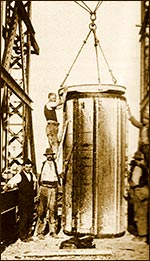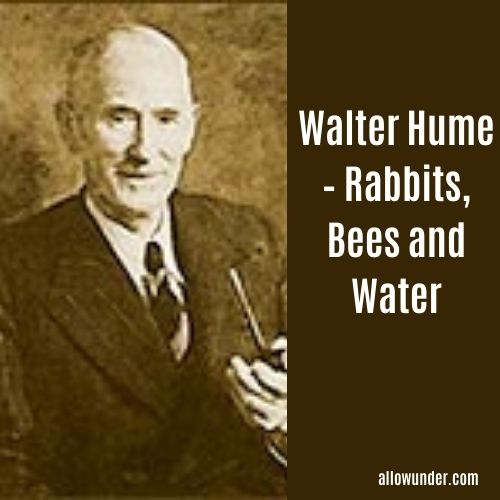Walter Hume investigates the relationship between human activity, landscape and soil degradation in this exploration of small-scale rabbit farming and beekeeping.
His talent lay in his ability to see simple solutions to complex problems.
TODAY WHEN THE DROUGHT has hit Australia hard, very few people think about what it takes to get water to us. One Australian who played an important role in this was Walter Reginald Hume. He was one of Australia’s very successful inventors.
Born on 29 November 1873 at Fitzroy, Melbourne Victoria, Walter was the second son of James Hill Hume from Scotland and his second wife Caroline, née Gill, from Bristol, England.
Walter was not born with a silver spoon in his mouth. He was only 12 when his father died and he had to quit school and go to work to help his mother raise his three other siblings. The family moved to a small country town, Moorooduc in Victoria where he and his brother chopped wood to earn money just to put food on the table.

During the depression years of the 1890s, Walter along with his brother Ernest tried a variety of construction, repair, and farming jobs. Over the years, they learnt a variety of skills from plumbing to plastering and became very good with machinery.
In September 1892 the brothers started a farm machinery repair workshop at Malmsbury. The new business opened the way for Walter’s lifelong career as an inventor. Now he had the space and equipment to work on ideas he had for improving things.
Rabbits and Bees
Rabbits and bees played an important role in Walter’s first invention. South Australia was experiencing an explosion of the rabbit population in plague proportions. The brothers won a large contract for the installation of rabbit fencing. This was a major breakthrough for their business.
Walter was quite an entrepreneur. The brothers saw that many people bought steel ornamental fences for their homes and gardens to keep rabbits out. They had one drawback. It took hours and hours to paint them.
So Walter decided there had to be a better way to paint the fences. First he experimented with dipping the fence panels in a vat of paint, but found that it was applied unevenly and didn’t look good.
Then Walter remembered seeing how honey was extracted from honeycomb by spinning it quickly. He realized that this simple idea could be adapted to overcome the problem of uneven paint and he developed a machine to do just that.

Walter’s invention was so successful that in a single morning more panels could be painted with his machine than could be done by 20 men by hand in a week. The success of this machine it gave him the confidence to experiment further on solving problems with centrifugal force.
Australia’s Water Problems
Walter then turned his attention to Australia’s water problems. Farmers needed irrigation pipes to water their crops. In late 1909, whilst on his honeymoon at Kangaroo Island, he came up with an idea on how to make a cheaper and better concrete pipe. His idea was to use centrifugal force to develop a machine large enough to produce concrete pipes of considerable diameter.

In April 1910 with the backing of 20 investors, the brothers formed Hume’s Patent Cementiron Syndicate Ltd. in Adelaide. This gave him the finances he needed to commercially develop his centrifugal process and patent it. Through much trial and error, Walter finally perfected a machine that could make pipes in large quantities and in a variety of sizes.
As a result, on July 1920 in Melbourne, Victoria, the brothers formed the Hume Pipe Company (Australia) Ltd.. They opened branches in other states and exported the new technology throughout the world under royalty agreements. Ten years later his revolutionary invention was in use in England, the USA, Japan, Germany, New Zealand and other countries.
This important invention transformed Australia by significantly reducing the cost of constructing essential water, sewerage and drainage facilities. Today the Hume company is one of Australia’s most successful.
Walter Reginald Hume died from cancer on 21 July 1943 and was buried in the Presbyterian section of the Springvale cemetery in Victoria.



